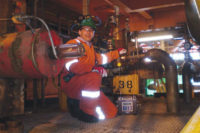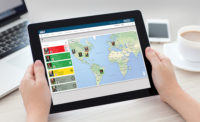Safety’s surge in the energy industries
Gas detection goes wireless
Access real-time threat data from virtually anywhere

Brown received company accolades and an award for enhancing safety at the Gulf of Mexico plant using a customized wireless solution. The comprehensive system provides continuous monitoring of about 100 storage tanks for hazards such as hydrogen sulfide (H2S) and sulfur dioxide (SO2) at the facility’s 680-acre tank farm.
Monitoring solutions once unimaginable
Wireless gas detection is being adopted in a wide range of industrial applications today — including oil and gas refinement, chemical production, coal-fired power production and animal-rendering plants. Similar to the transition of consumer electronics and computer industries to wirelessly networked systems that provide new and improved capabilities, wirelessly connected gas-detection instruments and systems enable a host of new, efficient monitoring solutions unimagined in years’ past.
At the heart of the shift to wireless is real-time connectivity. Advances in secure Internet access and the ability to get data onto the Internet from almost anywhere have made these real-time interactions possible. Such access to data has now become an operational advantage to globally distributed safety teams as well as multinational firms. For these organizations, deploying wireless instruments can reduce installation and system-management costs, and reduce project downtime. At the same time, these tools can improve incident response times, and provide automated verification of regulation compliance and safety standards.
The old model of “one man, one instrument” continues to give way to instruments capable of connecting and sending data in real time to a centralized operations center. New solutions provide larger, more complete views of safety networks and typically require fewer people to monitor and manage the system.
Real-time emergency response
|
Benefits of wireless gas-detection |
|
With wireless gas detection, if an incident happens, alarms immediately alert workers in the area while monitors send alarm information to operations-center personnel, who can initiate an emergency response faster than ever before. Plant operators also can be alerted in real time of remote man-down alarms or dangerous physiological vital signs of team members in stressful or potentially hazardous environments, such as confined spaces.
Using wireless gas monitoring, data gets sent securely in real time and can be monitored by remote devices, which can be located onsite or at an offsite facility. The data can be captured and stored digitally with GPS (global positioning satellite) location coordinates, time stamp and concentration data to document incidents and confirm adherence to regulations.
Building “big data” analytics
Advanced software brings it all together. Real-time instrument monitoring, management and control software provides support for continuous operation that remotely tracks hundreds of wireless monitors at one time and aggregates readings from multiple locations into a dynamic map display.
Handheld and personal gas monitors can utilize wireless modems to seamlessly connect to an established monitoring network. In addition, safety data can now be integrated with existing industrial systems and software applications, including predictive analytics and automated process-control systems. This allows safety managers to extend safety monitoring and process-control capabilities to include real-time threat data for the safest environment possible.
A precedent-setting open XML-based software developer’s kit (SDK) integrates real-time instrument data with external process-control applications, such as Supervising Control and Data Acquisition (SCDA) systems that monitor vital infrastructure and processes. Using SDK, developers and third-party manufacturers can build custom solutions to meet specific application needs.
Focus on work, not monitoring
Aquilex HydroChem, a Texas-based company that provides integrated services in industrial cleaning, has embraced wireless gas-detection technology to meet Method 21 guidelines developed by the U.S. Environmental Protection Agency (EPA).
For Aquilex HydroChem, the use of these systems on its industrial vacuum trucks helps its customers meet, and often exceed, new stringent regulations for cleanup operations, said Scott Holland, a regional maintenance manager for Aquilex HydroChem. By sending information to a centralized location at a job site, a single person can monitor multiple trucks working on different jobs at the facility.
“The wireless capability enables our work crews to stay focused on their area of expertise, and not have to worry about monitoring vapor emissions,” Holland said. Real-time connectivity also allows the company to provide detailed reports to verify monitored data — all generated automatically using a wireless gas-detection system. Automated bump and calibration systems also are widely available to simplify daily maintenance of the instruments, several with one-button operation.
Browser-based gas monitoring
Industrial facilities also are taking a page from consumer wireless technology. Increasingly, industrial plants are installing ubiquitous wireless communication networks that facilitate improved connections and provide Internet access. New browser-based gas-monitoring systems provide simple access to threat-detection data from virtually anywhere at any time. These wireless systems can send alert notifications via email in the event of an incident and provide easy access to secure, closed-loop threat-detection networks by authorized users through smartphones and iPad browsers.
The net result of these advances in wireless gas-detection monitoring means plant safety managers gain better visibility and control over their safety networks. No longer can remote workers using an unconnected, standalone detection meter dismiss or ignore alarms. Wireless instruments collect and send data in real time to the operations center, so all reading spikes or alarms are addressed. Additionally, dangerous trends in data readings can often be spotted before an instrument goes into alarm, further enhancing safety and reducing time-consuming incidents.
Source:
“Wirelessly Networked Chemical & Radiation Detection Systems: Essential Technologies and Applications for Increased Safety in Continuous Gas and Radiation Monitoring” by RAE Systems. It’s available at Amazon Books.
Looking for a reprint of this article?
From high-res PDFs to custom plaques, order your copy today!






